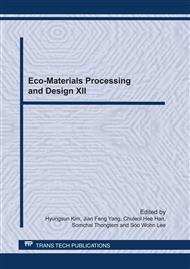p.577
p.581
p.585
p.589
p.594
p.598
p.602
p.606
p.610
Preparation of Fluorine Doped Tin Oxide Film by Ultrasonic Spray Pyrolysis
Abstract:
Fluorine doped tin oxide (FTO) film is one of the most promising transparent conducting materials. It can be used for Low-E glasses, thin film solar cells, displays, etc. FTO film can be fabricated by various techniques. The technique of sol-gel combined with ultrasonic spray pyrolysis gives the possibility to produce high-quality large-scale FTO films. In this paper, the FTO sol is successfully prepared using pentahydrate stannic chloride (SnCl4•5H2O), hydrogen fluoride (HF) and methanol. Using the FTO sol, FTO films are prepared by ultrasonic spray pyrolysis technique. X-ray diffraction (XRD), X-ray photoelectron spectroscopy (XPS), scanning electron microscopy (SEM), and atomic force microscopy (AFM) are used to characterize the FTO films coated on glass substrates. Results indicate that the as-deposited films are polycrystalline SnO2 phase with tetragonal crystal structure, and that the average grain size for the samples is 160nm. The optical and electrical properties of the FTO film are also analyzed.
Info:
Periodical:
Pages:
594-597
Citation:
Online since:
July 2011
Authors:
Keywords:
Price:
Сopyright:
© 2011 Trans Tech Publications Ltd. All Rights Reserved
Share:
Citation:


